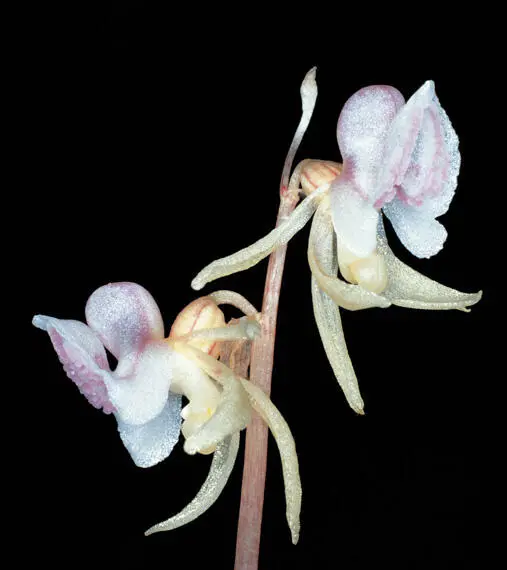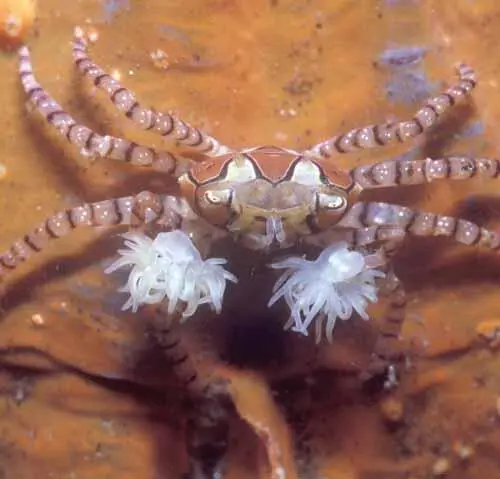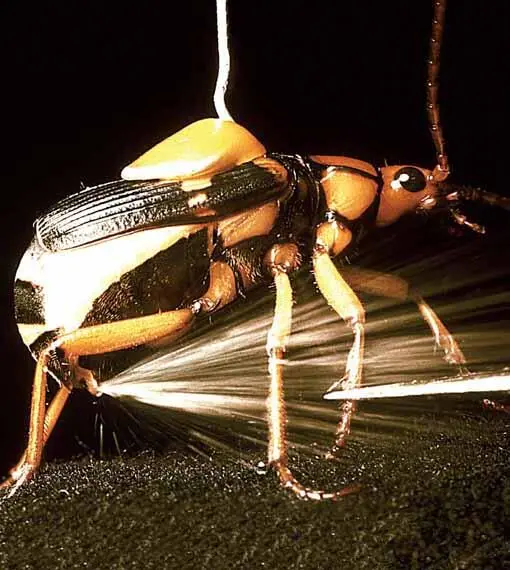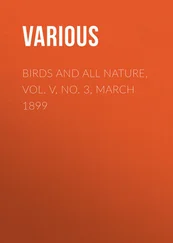Ultimately, the aim of the book is simply to revel in these other-worldly creatures and their outlandish behaviour. We hope you enjoy being wowed by some of their exploits.
Most devious plant· Strangest boxer· Most explosive defence· Most poisonous animal· Most ingenious tool-maker· Most gruesome partnership· Best electro-detector· Stickiest skin· Deadliest plant· Biggest blood-sucker· Keenest sense of smell· Most enthusiastic singer· Most gruesome tongue· Most inquisitive bird· Biggest drug-user· Most painful stinger· Slipperiest plant· Heaviest drinker· Best mimic· Most formidable killer· Best architect· Most painful tree· Loudest bird call· Deadliest drooler· Most sensitive slasher· Smelliest plant· Most impressive comeback· Hottest animal· Most shocking animal· Coldest animal· Most talkative animal· Most bizarre defence· Smelliest animal· Slimiest animal· Keenest hearing· Stickiest spitter· Best colour vision· Most dangerous snake
| NAME |
ghost orchid Epipogium aphyllum |
| LOCATION |
North and Central Europe east to Japan |
| ABILITY |
cheating a fungus |

© Jeffrey Wood/Royal Botanic Gardens, Kew
The natural world as we know it is built on partnerships. But in all societies there are cheats, and plants are no exception. Most green plants would be unable to exist without the help of fungi, which provide them with food-exchange partnerships. In fact, the invasion of the land by plants – algae – was probably only made possible by such partnerships. It has even been suggested that early land plants developed roots just so they could join forces with the fungal roots, or hyphae.
Most plants are proper partners, giving the carbohydrates they manufacture with their chlorophyll. Some, notably orchids, have such a close partnership that they don’t even bother to produce proper food packages to accompany their embryos into the world, instead relying on fungi in the soil to provide the food needed for germination and early growth. This allows an orchid to produce lightweight, microscopic seeds – millions of them.
Some orchids, however, have become cheats: they use fungi that have partnerships with trees, and they never give anything in exchange. Via fungal hyphae, these orchid vampires tap into the trees, siphoning off nutrients. The give-away is often the fact that they have stopped producing chlorophyll and so aren’t green but a rather sickly pinkish cream, like the ghost orchid, or brown, like the bird’s-nest orchid. Some, such as western coralroot, are blood red or even purple. The drawback is that, without the fungus, the orchid will die. And one day a fungus might just evolve a way to get its own back.
| NAME |
boxer crab, or pom pom crab, Lybia species |
| LOCATION |
Indian and Pacific Oceans |
| ABILITY |
packing a punch with anemone gloves |

© Roger Steene/imagequest3d.com
Mutual relationships in the sea are common. A famous one is between a hermit crab and an anemone, where the former gains protection from the anemone’s stinging nematocysts, and the latter gets leftover food. Boxer crabs seem to have taken this a stage further. These tiny crabs – their carapace measures just 1.5cm (0.6in) – are prey to many animals. Their defence is to wield minute, stinging anemones on specialised claws. A jab with a ‘glove’ can cause pain (even to a human) or death and seems an effective defence – one boxer has even been observed seeing off a blue-ringed octopus. The anemones are also used in crab-to-crab boxing. But such fights are ritualistic, and boxing opponents hardly ever touch each other with their anemones, grappling instead with their walking legs.
When a growing boxer has to moult, it must put down its anemones and then grab them again when its new carapace (outer covering) has hardened. If it then finds itself with just one anemone, it merely breaks it in two, and the anemone obligingly duplicates itself. Surprisingly, the anemones don’t seem to object to being picked up or to being brandished in the face of a predator – at least, one hasn’t been seen trying to escape. And it’s hard to tell what it gets in return other than free travel, but since the boxer uses the anemone to stun food animals, maybe the anemone gets enough leftovers to make life on the claw worth it.
| NAME |
bombardier beetlesCarabidae family |
| LOCATION |
on every continent except Antarctica |
| ABILITY |
mixing chemicals to create an explosion |

© Thomas Eisner & Daniel Aneshansley/Cornell University
In the world of insects, ants can overcome almost anything. But they don’t always have it their own way. Bombardier beetles deliver an anti-ant surprise that is positively explosive. An ant, a spider or any other predator that, say, clamps on to a beetle’s leg with hostile intent instantly finds itself blasted with a chemical spray that’s as hot as boiling water.
So how does a small, cold-blooded creature manage to do this? Pure chemistry: in the rear of its abdomen are two identical glands lying side by side and opening at the abdominal tip. Each has an inner chamber containing hydrogen peroxide and hydroquinones and an outer one with catalase and peroxidase. When chemicals in the inner chamber are forced through the outer one, the chemicals react together, and the beetle has effectively created a bomb.
The resulting vapour, now containing the irritants known as p -benzoquinones, explodes from the end of the abdomen with a bang that’s audible to a human and a temperature that’s scalding to the would-be predator. What’s more, the beetle can rotate its abdomen through 270 degrees in any direction, so that it can aim with absolute precision, and if 270 degrees isn’t enough, it can shoot over its back, hitting a pair of reflectors that will ricochet the spray at the extra angle needed. Scientists find bombardiers fascinating because they’re the only animals known to mix chemicals to create an explosion.
| NAME |
golden poison-dart frog Phyllobates terribilis |
| LOCATION |
Pacific rainforests of Colombia, South America |
| ABILITY |
producing the most deadly poison of any animal |
© Chris Mattison/FLPA
This tiny frog uses toxic chemicals as a defence in its body and is therefore technically poisonous (venomous animals inject toxins via a weapon – a tail, fang, spine, spur or tooth). The toxin is effective only when the frog is attacked, and since the frog doesn’t want to be harmed, it sports a brilliant yellow or orange colour to warn predators of extreme danger.
Читать дальше













![Various - Birds and Nature Vol. 11 No. 3 [March 1902]](/books/745532/various-birds-and-nature-vol-11-no-3-march-1902-thumb.webp)
![Various - Birds and Nature Vol. 9 No. 3 [March 1901]](/books/745788/various-birds-and-nature-vol-9-no-3-march-1901-thumb.webp)